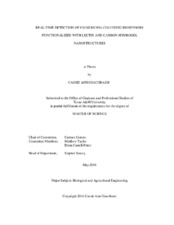| dc.contributor.advisor | Gomes, Carmen | |
| dc.creator | Giacobassi, Cassie Ann | |
| dc.date.accessioned | 2016-07-08T15:06:32Z | |
| dc.date.available | 2018-05-01T05:49:03Z | |
| dc.date.created | 2016-05 | |
| dc.date.issued | 2016-01-07 | |
| dc.date.submitted | May 2016 | |
| dc.identifier.uri | https://hdl.handle.net/1969.1/156825 | |
| dc.description.abstract | Foodborne pathogens are a major concern for the health and safety of the public. There is a need for a rapid, cost effective, and reliable detection method for foodborne pathogens to replace current highly technical and time consuming methods. Escherichia coli spp. are some of the most common foodborne bacteria. Concanavalin A was used in combination with platinum-graphene-platinum (PGP) and poly(N-isopropylacrylamide (PNIPAAm) to design an impedimetric biosensor for the real-time detection of non-pathogenic and pathogenic E. coli in PBS and in complex vegetable broth. Sensor performance was evaluated for sensitivity, lower detection limit (LOD), detection range, and detection time. Electroactive surface area (ESA) and actuation results testing for PNIPAAm were used to determine the most effective surface coating for E. coli detection. ESA values for bare, PGP, and PGP-PNIPAAm modified electrodes were calculated and generally increased (p < 0.05) with surface modification. Actuation of PNIPAAm, a thermo-responsive polymer, was tested, and results revealed 20 °C and 40 °C were the ideal temperatures for capturing and sensing bacteria, respectively. PGP results for ConA and antibody loaded at the same concentration were similar (p > 0.05). PGP-PNIPAAm yielded the best results with sensitivity of 38.005 ± 2.330 (log(CFU.mL^-1))^-1 and 3.467 ± 0.297 CFU.mL^-1 LOD. ConA specificity to E. coli was tested in PBS with Salmonella Enteritidis and performance parameters were found to be similar (p > 0.05) to those with E. coli only. PGP-PNIPAAm-ConA was tested in vegetable broth inoculated with E. coli O157:H7 and performance was compared to PGP-PNIPAAm-antibody. The antibody and ConA sensors performed similarly (p > 0.05) in broth regarding sensitivity, though the antibody was slightly superior with a larger detection range (10^2 –10^7 CFU.mL^-1) and lower (p < 0.05) LOD. The LOD for PGP-PNIPAAm-ConA was 39.06 ± 3.382 CFU.mL^-1 and 21.850 ± 3.459 CFU.mL^-1 for PGP-PNIPAAm-antibody. Response time for all sensors in this study was 17 minutes. Both ConA and antibody performance parameter results using PGP and PGP-PNIPAAm platforms were comparable to values reported in the literature. In PBS, ConA was superior to antibody in linear range of detection and the use of PNIPAAm for bacteria capture and sensing further improved sensitivity and LOD. The study showed there is great promise using ConA biosensors for pathogen detection in the food industry. | en |
| dc.format.mimetype | application/pdf | |
| dc.language.iso | en | |
| dc.subject | impedance biosensor | en |
| dc.subject | concanavalin A | en |
| dc.subject | graphene-nanometal hybrids | en |
| dc.subject | temperature-responsive nanobrushes | en |
| dc.subject | PNIPAAm | en |
| dc.subject | food safety | en |
| dc.title | Real-Time Detection of Escherichia coli Using Biosensors Functionalized with Lectin and Carbon-Hydrogel Nanostructures | en |
| dc.type | Thesis | en |
| thesis.degree.department | Biological and Agricultural Engineering | en |
| thesis.degree.discipline | Biological and Agricultural Engineering | en |
| thesis.degree.grantor | Texas A & M University | en |
| thesis.degree.name | Master of Science | en |
| thesis.degree.level | Masters | en |
| dc.contributor.committeeMember | Castell-Perez, Elena | |
| dc.contributor.committeeMember | Taylor, Matthew | |
| dc.type.material | text | en |
| dc.date.updated | 2016-07-08T15:06:32Z | |
| local.embargo.terms | 2018-05-01 | |
| local.etdauthor.orcid | 0000-0002-6898-0100 | |


